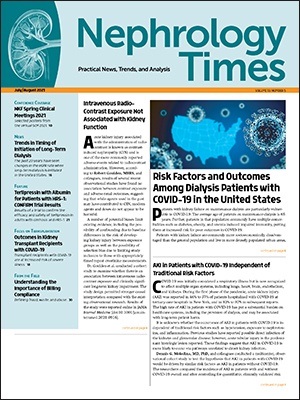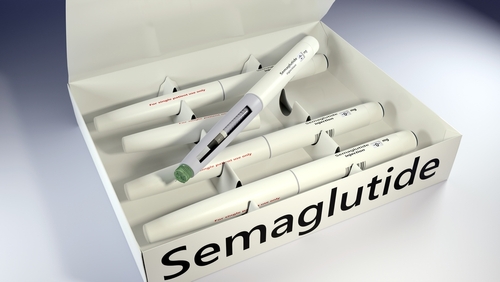
Key Takeaway
- Researchers conducted a regression discontinuity design (RDD) study to examine whether intravenous radiocontrast exposure is associated with clinically significant long-term renal impairment.
- The primary outcome of interest was estimated glomerular filtration rate up to 6 months following an index visit to the emergency department (ED) that resulted in receipt of a computed tomographic pulmonary angiogram.
- There was no evidence of an association between exposure to contrast and eGFR up to 6 months after the index ED visit or with the need for renal replacement therapy, mortality, and acute kidney injury.
The Study
Acute kidney injury associated with the administration of radiocontrast is known as contrast-induced nephropathy (CIN) and is one of the more commonly reported adverse events related to radiocontrast administration. However, according to Robert Goulden, MBBS, and colleagues, results of several recent observational studies have found no association between contrast exposure and adverse renal outcomes, suggesting that while agents used in the past may have contributed to CIN, modern agents and doses do not appear to be harmful.
A number of potential biases limit existing evidence, including the possibility of confounding due to baseline differences in the risk of developing kidney injury between exposure groups and the possibility of selection bias due to limiting study inclusion to those with appropriately timed repeat creatinine measurements.
Dr. Goulden et al. conducted a cohort study to examine whether there is an association between intravenous radiocontrast exposure and clinically significant long-term kidney impairment. The study design permitted stronger causal interpretation compared with the existing observational research. Results of the study were reported online in JAMA Internal Medicine [doi:10.1001/jamainternmed.2021.0916].
The study utilized regression discontinuity design (RDD) to overcome the limitations of the existing research. RDD relies on the existence of a continuous variable, the running variable, for which there is a cutoff that determines eligibility for receiving treatment. By comparing outcomes in those just on either side of the cutoff, the RDD approach can provide effect estimated from observational data that are largely free from both measured and unmeasured confounding. The study assessed individuals who received D-dimer testing (the running variable) in the emergency department (ED). Suspected pulmonary embolism is the most common indication for D-dimer testing; those scoring about the cutoff (typically 500 ng/mL) are more likely to receive contrast in the form of a computed tomographic pulmonary angiogram (CTPA) to rule in or rule out the diagnosis.
The primary outcome of interest was long-term kidney function, measured by estimated glomerular filtration rate (eGFR) up to 6 months following the index ED visit. Secondary outcomes were receiving kidney replacement therapy (RRT) (dialysis or kidney transplantation) in the 6 months following the index ED visit, AKI, defined as an increase in creatinine level of 50% or 0.3 mg/dL within 7 days, and all-cause mortality at 6 months.
The primary exposure was the receipt of CTPA during the index ED visit. Other covariates included in the statistical analyses were age, baseline eGFR, sex, diabetes, hypertension, cancer, coronary artery disease, ED triage score, and Charlson comorbidity index. All analyses were performed using Stata statistical software (version 15, Stata Corp.), with the primary and secondary analyses using the rdrobust package.
The study cohort included all patients ≥18 years of age in the Canadian province of Alberta presenting to the ED and undergoing D-dimer testing between April 1, 2013, and June 30, 2018. A total of 156,028 individuals met inclusion criteria and were included in the study. Mean age was 53 years, 44% (n=68,206) were men, and mean baseline eGFR was 86 mL/min/1.73 m2. Patients just above and below the CTPA eligibility cutoff were similar in terms of measured confounders.
Fifty-four percent of the cohort (n=84,624) had data on the primary outcome (long-term eGFR) available. Median time to the last eGFR test in the 6 months after the ED visit was 3.7 months. The software package automatically selected bandwidths of 80 ng/mL below and 1190 ng/mL above the cutoff, within which 29,830 patients were included.
In the local linear fuzzy RDD analysis, there was no association of intravenous contrast with long-term eGFR, with an eGFR change of –0.4 mL/min/1.73 m2 (95% confidence interval [CI], –4.9 to 4.0 mL/min/1.73 m2) attributable to CTPA exposure caused by crossing the D-dimer cutoff. Results of a sensitivity analysis in all 84,624 patients also found no evidence of an association, with an eGFR change of 0.4 mL/min/1.73 m2 (95% CI, –2.1 to 2.8 mL/min/1.73 m2) attributable to CTPA exposure. Eight sensitivity analyses used different bandwidths and polynomial orders; seven found no evidence of an association.
A total of 165 patients (0.11% of the total cohort) required RRT during the 6 months after the index ED visit (161 dialyses, four kidney transplants). There was no evidence of an association between CTPA exposure and the need for RRT (risk difference [RD], 0.07%; 95% CI, –0.47% to 0.61%). Among patients with repeated measurements of creatinine levels within 7 days, 9.7% (n=4147) developed AKI; there was no evidence of an association of contrast exposure with the risk (RD, 4.3%; 95% CI, –2.7% to 12.9%). Missing data limited the analysis for the association between CTPA exposure and AKI.
In the 6 months following the index ED visit, 6656 patients (4.3%) died. There was no evidence of an association between death and CTPA (RD, 0.3%; 95% CI, –2.9% to 3.2%).
In the subgroup analyses, there was no evidence of an association between contrast exposure and long-term eGFR based on baseline eGFR, age, or hypertension. Among patients with diabetes, the association was potentially consistent with harm but was not statistically significant, with an eGFR change of –6.4 mL/min/1.73 m2 (95% CI, –15.4 to 0.2 mL/min/1.73 m2; P for heterogeneity=.12). The subgroup analyses were relatively underpowered, the authors noted.
Citing limitations to the findings, the researchers mentioned the generalizability of the results of RDD analysis. Because the treatment effect is estimated for patients whose D-dimer value falls at the cutoff, it may not apply to patients further away from that value. The treatment effect is further restricted to those at the cutoff whose receipt of a contrast-enhanced scan is determined by the cutoff.
In conclusion, the researchers said, “To our knowledge, this study provides the strongest evidence to date that intravenous contrast is not associated with significant kidney injury, further challenging the considerable clinical preoccupation with the occurrence and prevention of CIN.”







 © 2025 Mashup Media, LLC, a Formedics Property. All Rights Reserved.
© 2025 Mashup Media, LLC, a Formedics Property. All Rights Reserved.